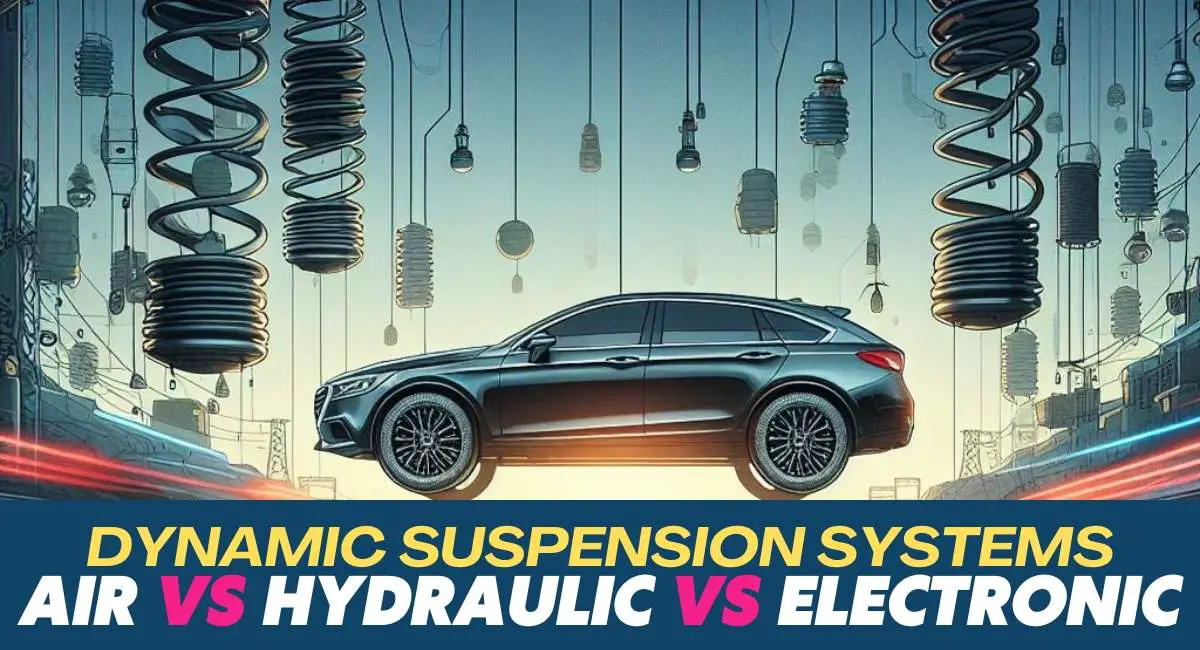While driving was a bit of a task in the past, today, technology makes this activity easy and fun. Manufacturers employ dynamic suspension systems. The suspension system enhances ride comfort, handling, and overall vehicle performance.
Plus, you have options! There are three main types of dynamic suspension systems: air, hydraulic, and electronic. Air suspension uses air springs for a smooth ride and adjustable height. Hydraulic suspension relies on hydraulic fluid for precise handling, which is common in sports cars. Electronic suspension integrates sensors for real-time damping adjustments, offering dynamic and customizable performance.
This article explores these three prominent suspension types by looking into their working principles, adjustability, and customization options, as well as their respective pros and cons.
Overview of Different Suspension Types
Dynamic suspension systems have a design that improves the ride quality, handling, and performance of a vehicle by adjusting the damping force of the shock absorbers according to the road conditions and driving style. There are three main types of dynamic suspension systems: air, hydraulic, and electronic.

Air Suspension
Air suspension is a cutting-edge technology that utilizes air springs to support the vehicle’s weight. Unlike traditional coil or leaf spring setups, air suspension allows for adjustable ride height and improved comfort. Initially developed for commercial vehicles, air suspension has gained popularity in luxury cars, SUVs, and even some mainstream models.
For instance, if you prefer a car with air suspension system, check out these cutting-edge vehicles, including the 2023 Rolls-Royce Cullinan, 2023 Mercedes AMG SL Roadster, 2023 Mercedes-Benz S-Class, 2024 Land Rover Range Rover, 2024 BMW 7 Series, 2023 Audi SQ8, 2024 BMW X7, and the 2023 Mercedes-Benz GLS starting at an MSRP of $81,800.
These models epitomize the transformative influence of air suspension on modern road travel. With sleek designs and advanced air suspension systems, these cars showcase how the technology is reshaping the automotive landscape, offering a combination of enhanced ride comfort, adjustable ride height, and dynamic handling for an unparalleled driving experience.
Hydraulic Suspension
Hydraulic suspension, on the other hand, relies on hydraulic fluid and a complex network of pumps, accumulators, and valves. It precisely controls damping and rebound, offering a responsive and dynamic driving experience. Although commonly associated with sports and performance cars, hydraulic suspension has applications in various vehicle segments.
Now, do you prefer the hydraulic system in your car? Several luxury automobiles and esteemed manufacturers like Rolls-Royce, Bentley, and Mercedes-Benz incorporate hydraulic suspension systems into their premium models.
Similarly, among sports car producers like Porsche, hydraulic suspension systems find application in their high-performance models, contributing to enhanced handling prowess.
Electronic Suspension
Electronic suspension represents the pinnacle of suspension technology, integrating sensors, accelerometers, and electronic control units (ECUs). This system continuously adjusts damping levels in real time, responding to road conditions and driving dynamics.
Electronic suspension is synonymous with unparalleled ride quality and adaptive capabilities in high-performance vehicles and luxury cars. The BMW X7 and Audi SQ8 are some of the SUVs with this type of suspension system. Besides, the Porsche Taycan is an electronic sports car with an electronic suspension system.
But these are just some examples of car models that have electronic suspension. Many other models from different brands also use this technology, such as Mercedes-Benz, Tesla, Jaguar, and Land Rover.
Working Principles of Air, Hydraulic, and Electronic Suspensions
The working principles of air, hydraulic, and electronic suspensions are as follows:
Air Suspension
Air suspension operates on air compression and decompression within the air springs. The system includes a compressor, air springs, height sensors, and an electronic control unit (ECU). When the vehicle’s height deviates from the preset level, the ECU activates the compressor to adjust the air pressure in the springs, ensuring a constant ride height.
The control module receives inputs from various sensors, such as height, speed, and steering angle sensors. It adjusts the air pressure accordingly to maintain the desired ride height, level, and comfort.
Hydraulic Suspension
Hydraulic suspension relies on hydraulic fluid properties to control the vehicle’s movements. A pump circulates hydraulic fluid through the system, and as the fluid passes through various components like shock absorbers, it dampens vibrations and provides a smooth ride.
Hydraulic suspension can adapt to driving conditions by adjusting the damping force through valves. Electronic suspension employs advanced sensors to monitor parameters such as wheel movement, vehicle speed, and acceleration.
The processing of the information collected by the ECU adjusts the damping levels of each shock absorber in real-time. This continuous adaptation allows the electronic suspension to deliver optimal performance across diverse driving scenarios.
Adjustability and Customization Options
Air suspension offers unparalleled adjustability, allowing drivers to modify the ride height based on preferences or specific driving conditions. Some systems have variable stiffness settings, balancing comfort, and sporty handling. Additionally, air suspension excels in load-leveling, automatically adjusting when towing or carrying heavy loads.
Hydraulic suspension provides customizable damping force settings, enabling drivers to fine-tune their ride experience. While ride height adjustment may be more limited than air suspension, hydraulic systems often come equipped with active suspension modes that optimize performance for various driving conditions, such as sports or comfort.
Electronic suspension systems take customization to new heights with programmable settings that cater to individual preferences. These systems can adapt to changes in driving conditions on the fly, offering a seamless transition between comfort and performance-oriented setups. The integration with vehicle systems allows for a holistic approach to customization.
Pros and Cons of Each Suspension Type
Now, let’s see an overview of the pros and cons of air, hydraulic, and electronic suspension systems, covering aspects such as ride quality, adjustability, applications, system integration, maintenance, cost, handling, versatility, and common manufacturers. Remember that individual system performance may vary based on specific models and implementations.
Air Suspension
Pros:
- Smooth Ride Quality: Air suspension provides a plush and comfortable ride, smoothing out bumps and imperfections in the road.
- Adjustable Ride Height: The ability to adjust ride height enhances versatility and accommodates different driving scenarios.
- Load-Leveling: Ideal for towing and carrying heavy loads, as air suspension automatically levels the vehicle.
Cons:
- Cost of Maintenance: Air suspension systems can be costly, especially if issues arise with the compressor or air springs.
- Potential for Air Leaks: The complex nature of air suspension introduces the risk of air leaks, impacting system performance.
- Complexity: The intricate design of air suspension systems can be challenging to troubleshoot and repair.
Hydraulic Suspension
Pros
- Excellent Damping Control: Hydraulic suspension provides precise control over damping, resulting in responsive handling and improved performance.
- Responsive Handling: Commonly found in sports and performance cars, hydraulic suspension enhances the vehicle’s agility and responsiveness.
- Active Suspension Features: Many hydraulic suspension systems come equipped with active modes, optimizing performance for different driving conditions.
Cons:
- Potential for Fluid Leaks: Like air suspension, hydraulic systems are susceptible to fluid leaks, requiring regular maintenance.
- Limited Ride Height Adjustment: Hydraulic systems may offer limited ride height adjustment options compared to air suspensions.
- Maintenance Costs: The complexity of hydraulic suspension systems can translate to higher maintenance costs.
Electronic Suspension
Pros:
- Dynamic and Adaptive Performance: Electronic suspension continuously adapts to changing road conditions, providing a dynamic and adaptive driving experience.
- Precise Control over Damping: The ability to adjust damping levels individually for each shock absorber results in unparalleled control and comfort.
- Integration with Vehicle Systems: Electronic suspension seamlessly integrates with other vehicle systems, contributing to overall performance.
Cons:
- Initial Cost: The advanced technology and complexity of electronic suspension systems contribute to higher initial costs.
- Complexity and Potential for Electronic Failures: The intricate nature of electronic suspension systems poses a risk of malfunctions and electronic failures.
- Maintenance Challenges: Repairing electronic suspension systems may require specialized knowledge and tools, potentially increasing maintenance challenges.
Comprehending these advantages and drawbacks empowers consumers to make knowledgeable choices aligned with their driving preferences, vehicle usage patterns, and budget constraints.
What are the Best Suspension Systems for Off-Roading?
There is no definitive answer to the best suspension system for off-roading, as different types of suspensions have pros and cons depending on the terrain, vehicle, and driving style. However, some general factors to consider when choosing a suspension system for off-roading are:
- Durability: The suspension system should withstand the impact, stress, and wear and tear of driving on rough and uneven surfaces. It should also be resistant to corrosion, dust, and water.
- Adjustability: The suspension system should adapt to different driving modes and road conditions, such as sport, comfort, or off-road. It should also allow the driver to change the ride height, level, and stiffness of the vehicle according to their preference and needs.
- Performance: The suspension system should improve the handling, stability, and agility of the vehicle, as well as reduce body roll, pitch, and bounce. It should also provide a smooth and comfortable ride and enhance the traction and grip of the tires.
Based on these factors, some of the most popular and recommended types of suspension systems for off-roading are:
Coil spring suspension
As the name suggests, coil springs come from coiled metal springs. This suspension supports the vehicle’s weight and absorbs the shocks from the road. Coil spring suspension is more durable and can handle rough terrain better than other suspensions. It also offers a high degree of adjustability and a smooth and comfortable ride. However, coil spring suspension is also costly and complicated, adding weight and complexity to the vehicle.
Leaf spring
This type of suspension uses flat metal stacked strips to form a spring. Leaf spring suspension is simple, cheap, and easy to maintain. It can also support heavy loads and is suitable for rough terrain. However, leaf spring suspension is noisy, stiff, and prone to sagging and breaking. It also limits the articulation and travel of the axle and the vehicle’s performance and handling of the car.
Air suspension
As mentioned, this suspension type uses pressurized air to inflate or deflate air springs that support the vehicle’s weight. Air suspension can provide a smooth and comfortable ride, adjust the ride height, and level the car when carrying heavy loads. However, air suspension is also expensive, complex, and prone to leaks and failures. It also requires electrical power and a compressor to operate.
These are just some examples of suspension systems that are suitable for off-roading. Many other types and variations of suspensions, such as hydraulic, electronic, independent, solid axle, multi-link, and double-wishbone, have advantages and disadvantages.
So, the best suspension system for off-roading depends on your personal preference, budget, and intended use of your vehicle. You can modify and customize your suspension system to fit your needs and goals.
Conclusion
Understanding the nuances of air, hydraulic, and electronic suspension systems is crucial for making informed decisions about a vehicle’s ride quality and performance. Each suspension type has unique advantages and drawbacks, catering to different driving preferences and requirements. As automotive technology evolves, suspension systems play a pivotal role in shaping the future of comfortable and dynamic driving experiences. Whether you prioritize adjustability, precise control, or adaptive capabilities, the right suspension choice can transform your driving journey.
